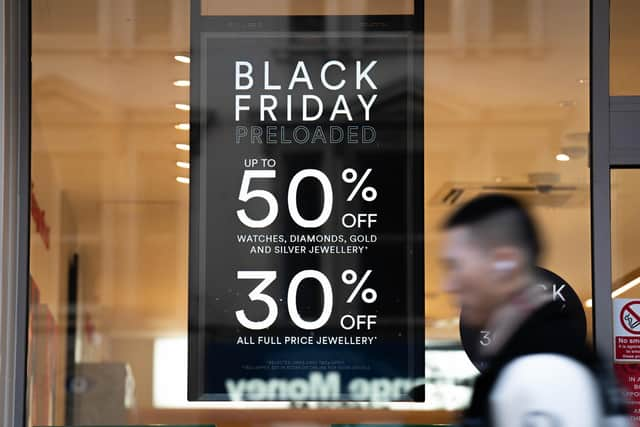Are Black Friday deals really worth the hype? - Rocio Concha of Which?
For consumers, it can be both exciting and daunting in equal measure.
The prospect of grabbing a bargain is enticing.
The thought of missing out on a great, time-limited deal - whether it’s for yourself or a loved one as you get on top of Christmas shopping early - is too much for some to bear.


Advertisement
Hide AdAdvertisement
Hide AdBut there’s a darker side to Black Friday, with potential pitfalls that consumers should be wary of.
The first is that, despite the avalanche of ‘great deals’, many turn out to be nothing of the sort.
This year, Which? analysed over 200 Black Friday deals over the previous 12 months from eight major home and tech retailers. These included the likes of Amazon, Argos and Currys.
The consumer group found that only two per cent of products on offer are at their best price on the day of the sales extravaganza.
Advertisement
Hide AdAdvertisement
Hide AdThat’s not to say Black Friday is a complete waste of money.
If an item you desire or need is being sold at a reduced price, then it may well make sense to buy it.
But there are some steps that consumers can take to ensure they are not being taken in by the Black Friday hype.
One tip is to compare the price of an item across multiple sites, another is to check the price history on sites such as PriceSpy and Pricerunner to see how long these products have been listed at that price.
Advertisement
Hide AdAdvertisement
Hide AdThe second pitfall is the potential for the products we buy to be at best not as described and at worst dangerous.
A recent report from the Office for Product Safety and Standards (OPSS) found that over 80 per cent of low quality items sold via online marketplaces fail safety tests, including toys being strangulation hazards for small children.
I have written in these pages before on the sheer volume of faulty or dangerous products available to buy on some of the world’s largest online marketplaces, from established giants like Amazon and eBay to the emerging Chinese-owned Temu - sites that many consumers will likely turn to for Black Friday deals.
However, the pace of action to deal with these dodgy products and the harms they can cause remains painfully slow.
Advertisement
Hide AdAdvertisement
Hide AdThe government’s review into product safety, launched in 2021, finally consulted on reforms this summer, but tough decisions needed to protect consumers won’t happen anytime soon.
The government is fond of talking about cutting red tape and unnecessary bureaucracy for companies but the OPSS acts out of the Department for Business and Trade.
For consumers to feel properly protected when shopping online, free of the threat of dangerous products, the government should make the OPSS properly independent, with real teeth to punish poorly behaving firms with hefty fines.
The third and final pitfall is fraud.
Scams are an all-year-round phenomenon, but events such as Black Friday are like gold dust for potential fraudsters.
Advertisement
Hide AdAdvertisement
Hide AdThe bank TSB recently reported that purchase scams, where victims are deceived into paying for an item or service that doesn't exist, are the largest driver of the scam cases they are seeing.
The banking industry's trade body UK Finance revealed there were 77,000 cases of this type of scam in the first six months of 2023 - more than 400 a day.
To protect yourself from the scammers, it’s best to completely avoid any offers that appear too good to be true (there is a reason why it’s a cliche).
If the site you’re browsing is littered with spelling mistakes, blurry imagery or no contact information, then these are all tell-tale signs of a scam.
Finally, avoid paying via bank transfer - a method the fraudster will likely insist on - as you’ll have fewer protections should something go wrong.